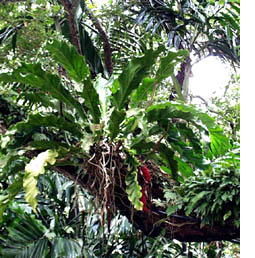
Rainforests
What is a Tropical Rainforest?
First, as the name indicates, tropical rainforests are found in the tropics located between the Tropic of Capricorn and the Tropic of Cancer, between the latitudes of 23.5° N and 23.5° S. Second, a tropical rainforest is rainy and wet, receiving at least 100 inches of rain each year. Other types of tropical forests experience one or two distinct dry seasons. So, a simple definition for tropical rainforest is: a forest in the tropics which receives rain throughout the year.
Within this definition, however, exists considerable variation. The rainforest's location in the world, the species it contains, the amount of rainfall it receives, soil conditions, elevation and associated temperature ranges are some of the things that influence the appearance of a rainforest. One of the defining characteristics of a rainforest is the tremendous diversity of life that exists within the forest. In fact, most of the world's plants and animals live in rainforests.
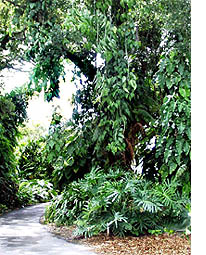
The diversity of life is displayed in an almost dizzying array of sizes, forms and colors. Nevertheless, certain characteristics appear in rainforests around the world. Some of the big trees in a rainforest have buttressed trunks, that is the trunk widens at the base with thin vertical plank-like structures. In architecture, buttresses are used to provide sturdy support with a minimum of materials. Woody vines, or lianas, which look like huge cables, grow to diameters of a foot or more. The stems of these vines loop through the rainforest understory and rise to spread their leaves high up on the top of the canopy where light is abundant. Epiphytes grow on tree trunks and branches high above the ground, where the light is brighter. Some epiphytes, like ferns and anthurium, survive in the dark understory while others, like certain orchids, grow high in the rainforest canopy where the sunlight is brightest. Large-leafed understory plants, like heliconias and palms, are found in the rainforest understory and in forest openings.
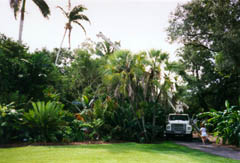
A tropical rainforest is rich, luxuriant and fascinating. It is a place of earthy, humid smells, a surprisingly wide array of sounds and calls, flashes of color and subtle camouflage. The tastes of tropical cuisines and unusual fruits can be very exciting. If you are willing to explore, the rainforest will engage all of your senses in ways that may be very basic or quite sophisticated.
What is Fairchild's Tropical Rainforest?
The Fairchild rainforest is a two-acre, outdoor exhibit of tropical rainforest plants from around the world, especially plants of the American tropics. The adjacent conservatory contains rainforest plants that will not survive outdoors in subtropical south Florida. Thanks to a grant from Mr. Robert M. Kramer, trustee of the Richard H. Simons Charitable Trust, Fairchild is now able to enhance this exhibit. The outdoor rainforest exhibit and the conservatory have easily accessible paths to rainforest information. Unlike a rainforest in the wild, the pathways are paved and the plants are labeled. In the Fairchild rainforest, visitors enjoy typical lush vegetation, including epiphytes and lianas (woody vines), without worrying about such unpleasantries as stinging ants and malaria. Visitors see how plants adapt to survive, how plants and animals interact and how people benefit from rainforest plants. Most important are the stories which tell the tragedy of rainforest destruction around the world. We believe these rich environments are worth protecting. The Fairchild rainforest exhibit demonstrates why they are important to you.
Today, the Fairchild tropical rainforest is growing and changing. While it contains many interesting plants, we plan to continuously make it much more enjoyable and informative. A stream reminds the visitors that water is a crucial component of the rainforest. Interpretative signage, educational resources and other visitor information are in place.
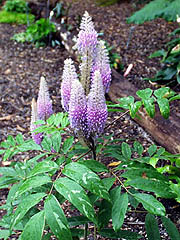 |
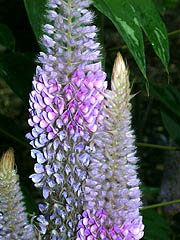 |
| The first bloom of a new plant - Uraria crinita 10/20/98 | |
Uraria crinita is one of 20 species of shrubby legume native to tropical S.E. Asia. The plants now in the Garden were grown from small, shiny, black seeds collected in July 1997 by David Bar-Zvi, Curator of Herbaceous Monocots. The mother plant was growing at the edge of a clearing in close proximity to a rubber plantation in Alo Gaja, near Melakka, Malaysia. The attractive, cylindrical purple and lavender inflorescences are reminiscent of diminutive, fuzzy lupins, were presented at waist height on sparse shrubby plants with pinnate leaves. The leaves themselves are ornamental being dark green with irregular splotches of lighter green, almost white. The plants were somewhat slow to develop in the earliest stages but eventually the strongest plants were chosen and some were placed into the outdoor rainforest lightgap exhibit. At near maturity the speed of development accelerated and the inflorescences elongated from button size to 6 or 7 inches long. A common name for this plant used in Malaysia is "Common Cat's Tail" due primarily to the furry cylindrical inflorescence shape, texture and even color as the last of the flowers is shed. It did not seem to be "common" where it was collected and it certainly isn't common in American gardens. It did not seem to be in any respect "weedy" and could possibly offer a new ornamental for warm climate gardens.
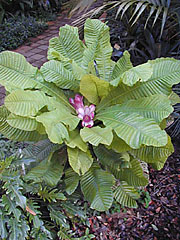 |
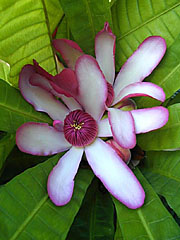 |
| Gustavia sp. bloomed on 12/20/99 and 4/11/02 | |
Gustavia monocaulis S. A. Mori was collected in Panama in February of 1995 by a staff member of Fairchild Tropical Botanic Garden. The specific location was the Darien Province, Rio Jaque Valley. It first bloomed on December 20th, 1999 when the tree was only three feet tall. The magenta and creme flowers are seven inches across. The genus Gustavia is in the Lecythidaceae family, along with the cannonball tree, Couroupita guianensis, and the Brazil nut, Bertholletia excelsa.
Copyright © 2005 Fairchild Tropical Botanic Garden,
10901 Old Cutler Road, Coral Gables, FL 33156 USA
Phone: (305) 667-1651 Fax: (305) 661-8953